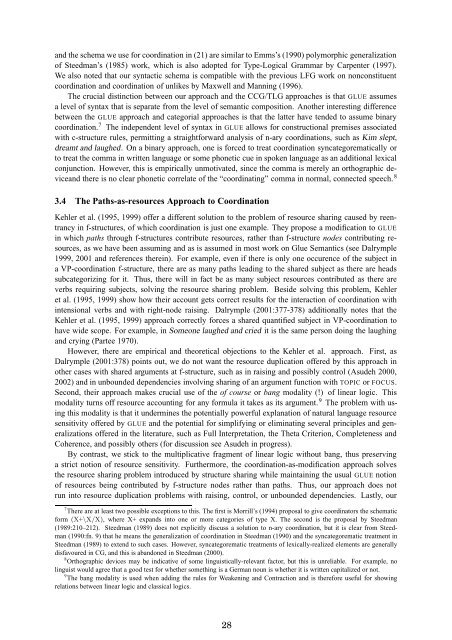Proceedings of the LFG 02 Conference National Technical - CSLI ...
Proceedings of the LFG 02 Conference National Technical - CSLI ...
Proceedings of the LFG 02 Conference National Technical - CSLI ...
Create successful ePaper yourself
Turn your PDF publications into a flip-book with our unique Google optimized e-Paper software.
and <strong>the</strong> schema we use for coordination in (21) are similar to Emms’s (1990) polymorphic generalization<br />
<strong>of</strong> Steedman’s (1985) work, which is also adopted for Type-Logical Grammar by Carpenter (1997).<br />
We also noted that our syntactic schema is compatible with <strong>the</strong> previous <strong>LFG</strong> work on nonconstituent<br />
coordination and coordination <strong>of</strong> unlikes by Maxwell and Manning (1996).<br />
The crucial distinction between our approach and <strong>the</strong> CCG/TLG approaches is that GLUE assumes<br />
a level <strong>of</strong> syntax that is separate from <strong>the</strong> level <strong>of</strong> semantic composition. Ano<strong>the</strong>r interesting difference<br />
between <strong>the</strong> GLUE approach and categorial approaches is that <strong>the</strong> latter have tended to assume binary<br />
coordination. 7 The independent level <strong>of</strong> syntax in GLUE allows for constructional premises associated<br />
with c-structure rules, permitting a straightforward analysis <strong>of</strong> n-ary coordinations, such as Kim slept,<br />
dreamt and laughed. On a binary approach, one is forced to treat coordination syncategorematically or<br />
to treat <strong>the</strong> comma in written language or some phonetic cue in spoken language as an additional lexical<br />
conjunction. However, this is empirically unmotivated, since <strong>the</strong> comma is merely an orthographic deviceand<br />
<strong>the</strong>re is no clear phonetic correlate <strong>of</strong> <strong>the</strong> “coordinating” comma in normal, connected speech. 8<br />
3.4 The Paths-as-resources Approach to Coordination<br />
Kehler et al. (1995, 1999) <strong>of</strong>fer a different solution to <strong>the</strong> problem <strong>of</strong> resource sharing caused by reentrancy<br />
in f-structures, <strong>of</strong> which coordination is just one example. They propose a modification to GLUE<br />
in which paths through f-structures contribute resources, ra<strong>the</strong>r than f-structure nodes contributing resources,<br />
as we have been assuming and as is assumed in most work on Glue Semantics (see Dalrymple<br />
1999, 2001 and references <strong>the</strong>rein). For example, even if <strong>the</strong>re is only one occurence <strong>of</strong> <strong>the</strong> subject in<br />
a VP-coordination f-structure, <strong>the</strong>re are as many paths leading to <strong>the</strong> shared subject as <strong>the</strong>re are heads<br />
subcategorizing for it. Thus, <strong>the</strong>re will in fact be as many subject resources contributed as <strong>the</strong>re are<br />
verbs requiring subjects, solving <strong>the</strong> resource sharing problem. Beside solving this problem, Kehler<br />
et al. (1995, 1999) show how <strong>the</strong>ir account gets correct results for <strong>the</strong> interaction <strong>of</strong> coordination with<br />
intensional verbs and with right-node raising. Dalrymple (2001:377-378) additionally notes that <strong>the</strong><br />
Kehler et al. (1995, 1999) approach correctly forces a shared quantified subject in VP-coordination to<br />
have wide scope. For example, in Someone laughed and cried it is <strong>the</strong> same person doing <strong>the</strong> laughing<br />
and crying (Partee 1970).<br />
However, <strong>the</strong>re are empirical and <strong>the</strong>oretical objections to <strong>the</strong> Kehler et al. approach. First, as<br />
Dalrymple (2001:378) points out, we do not want <strong>the</strong> resource duplication <strong>of</strong>fered by this approach in<br />
o<strong>the</strong>r cases with shared arguments at f-structure, such as in raising and possibly control (Asudeh 2000,<br />
20<strong>02</strong>) and in unbounded dependencies involving sharing <strong>of</strong> an argument function with TOPIC or FOCUS.<br />
Second, <strong>the</strong>ir approach makes crucial use <strong>of</strong> <strong>the</strong> <strong>of</strong> course or bang modality (!) <strong>of</strong> linear logic. This<br />
modality turns <strong>of</strong>f resource accounting for any formula it takes as its argument. 9 The problem with using<br />
this modality is that it undermines <strong>the</strong> potentially powerful explanation <strong>of</strong> natural language resource<br />
sensitivity <strong>of</strong>fered by GLUE and <strong>the</strong> potential for simplifying or eliminating several principles and generalizations<br />
<strong>of</strong>fered in <strong>the</strong> literature, such as Full Interpretation, <strong>the</strong> Theta Criterion, Completeness and<br />
Coherence, and possibly o<strong>the</strong>rs (for discussion see Asudeh in progress).<br />
By contrast, we stick to <strong>the</strong> multiplicative fragment <strong>of</strong> linear logic without bang, thus preserving<br />
a strict notion <strong>of</strong> resource sensitivity. Fur<strong>the</strong>rmore, <strong>the</strong> coordination-as-modification approach solves<br />
<strong>the</strong> resource sharing problem introduced by structure sharing while maintaining <strong>the</strong> usual GLUE notion<br />
<strong>of</strong> resources being contributed by f-structure nodes ra<strong>the</strong>r than paths. Thus, our approach does not<br />
run into resource duplication problems with raising, control, or unbounded dependencies. Lastly, our<br />
7 There are at least two possible exceptions to this. The first is Morrill’s (1994) proposal to give coordinators <strong>the</strong> schematic<br />
form (X+\X/X), where X+ expands into one or more categories <strong>of</strong> type X. The second is <strong>the</strong> proposal by Steedman<br />
(1989:210–212). Steedman (1989) does not explicitly discuss a solution to n-ary coordination, but it is clear from Steedman<br />
(1990:fn. 9) that he means <strong>the</strong> generalization <strong>of</strong> coordination in Steedman (1990) and <strong>the</strong> syncategorematic treatment in<br />
Steedman (1989) to extend to such cases. However, syncategorematic treatments <strong>of</strong> lexically-realized elements are generally<br />
disfavoured in CG, and this is abandoned in Steedman (2000).<br />
8 Orthographic devices may be indicative <strong>of</strong> some linguistically-relevant factor, but this is unreliable. For example, no<br />
linguist would agree that a good test for whe<strong>the</strong>r something is a German noun is whe<strong>the</strong>r it is written capitalized or not.<br />
9 The bang modality is used when adding <strong>the</strong> rules for Weakening and Contraction and is <strong>the</strong>refore useful for showing<br />
relations between linear logic and classical logics.<br />
28





